Discover 20 hidden attractions, cool sights, and unusual things to do in Sioux City (United States). Don't miss out on these must-see attractions: Orpheum Theatre, Sioux City Art Center, and Sergeant Floyd. Also, be sure to include Sioux City Public Museum in your itinerary.
Below, you can find the list of the most amazing places you should visit in Sioux City (Iowa).
Table of Contents
Orpheum Theatre
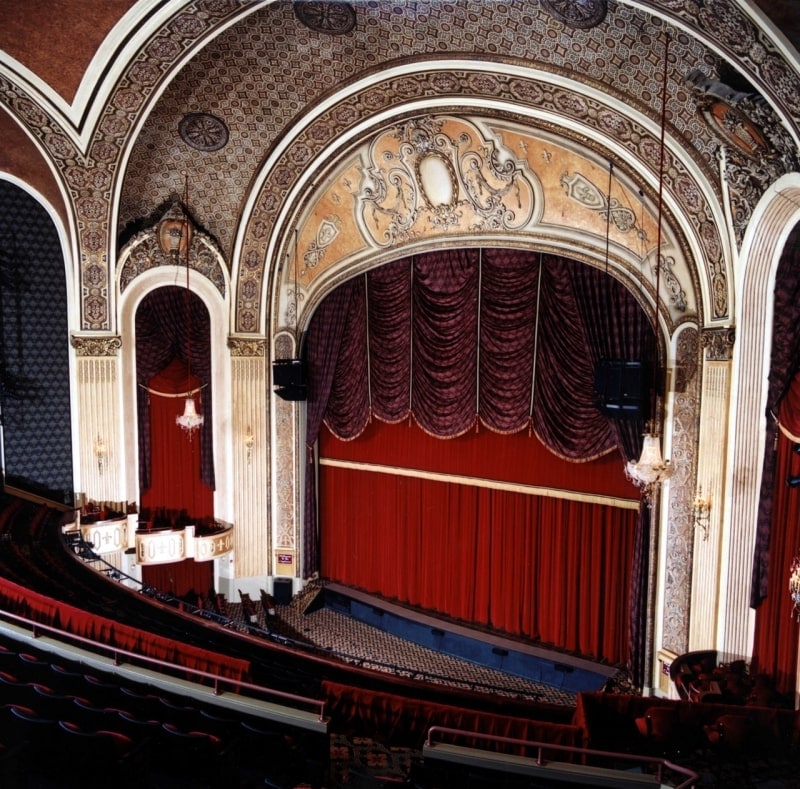
Theatre in Sioux City, Iowa. The Orpheum Theatre, also known as New Orpheum Theatre and Orpheum Electric Building, is a performing arts center located at 528 S. Pierce Street in Sioux City, Iowa. Built in 1927 as a vaudeville and movie palace, the theatre was restored in 1999 and today is the home of the Sioux City Symphony Orchestra.[1]
Address: Downtown Sioux City, 51105 Sioux City
Sioux City Art Center
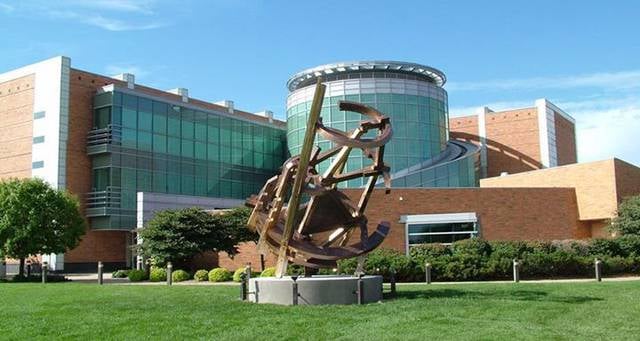
Art museum in Sioux City, Iowa. The Sioux City Art Center began as a Works Progress Administration project in 1937 when the Art Center Association of Sioux City, the Sioux City Junior League, as well as other community supporters, received a grant of $3,000 to create the first art center. After the Federal Assistance Program ended in 1940, the Sioux City City Council voted to fund the Art Center and established the Board of Trustees, the City's fiscal governing board for the Art Center in 1941. It is located in Sioux City, Iowa.[2]
Address: 225 Nebraska St, 51101-1712 Sioux City
Sergeant Floyd

Museum in Sioux City, Iowa. Sergeant Floyd is a historic museum boat, serving as the Sergeant Floyd River Museum & Welcome Center at 1000 Larsen Park Road in Sioux City, Iowa. Built in 1932 as a utility vehicle and towboat, she is one of a small number of surviving vessels built specifically for the United States Army Corps of Engineers in its management of the nation's inland waterways. The boat has been restored and drydocked, and now houses exhibits about the Missouri River and local tourism information. The museum is a facility of the Sioux City Public Museum.
She was declared a National Historic Landmark in 1989.[3]
Address: 1000 Larsen Park Rd, 51103-4914 Sioux City (West Side)
Sioux City Public Museum
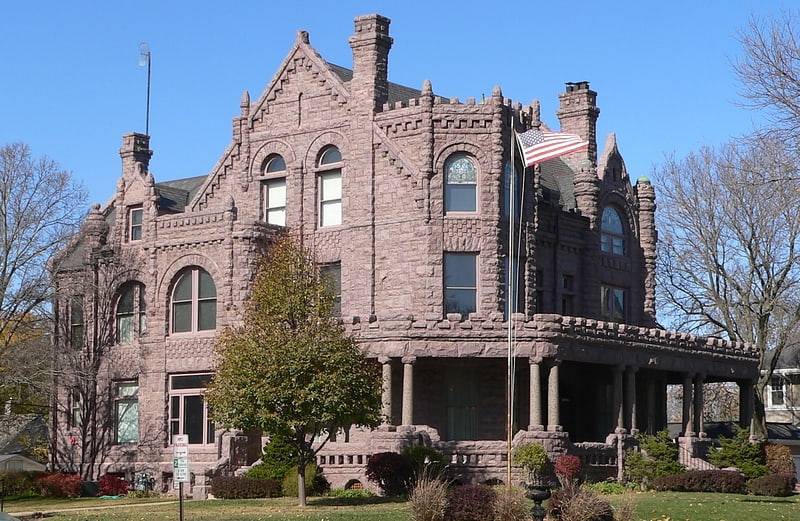
Museum in Sioux City, Iowa. The Sioux City Public Museum is a museum about the history and culture of Sioux City, Iowa. Displays include a video about the city's history, Native American artifacts, pioneer artifacts, historic transportation vehicles, agriculture, industry, geology and fossils.
The Sioux City Public Museum also operates the Sergeant Floyd River Museum & Welcome Center and the Peirce Mansion in Sioux City.[4]
Address: 607 4th St, 51101-1634 Sioux City
Cathedral of the Epiphany
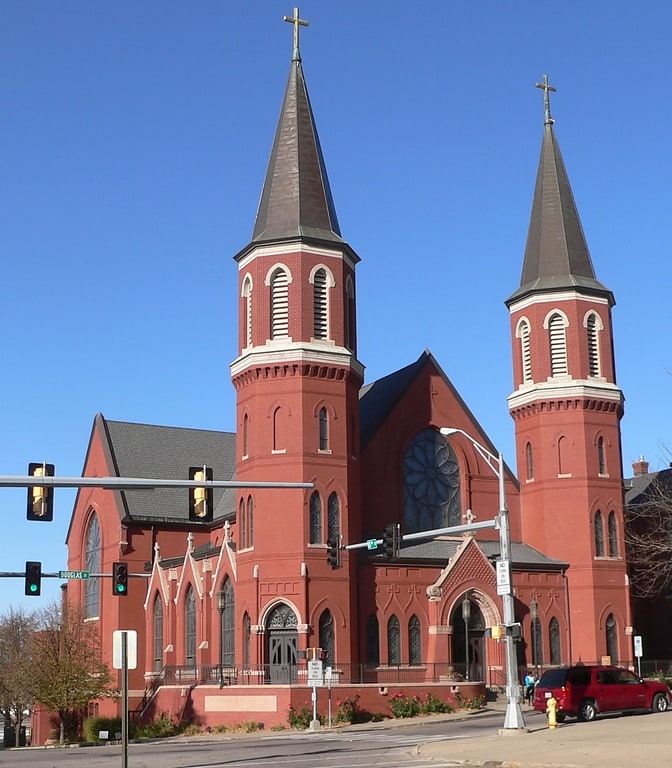
Cathedral in Sioux City, Iowa. The Cathedral of the Epiphany is a cathedral and a parish church located in Sioux City, Iowa, United States. It is the seat of the Diocese of Sioux City.[5]
Address: 1000 Douglas St, 51105 Sioux City (North Side)
Sergeant Floyd Monument
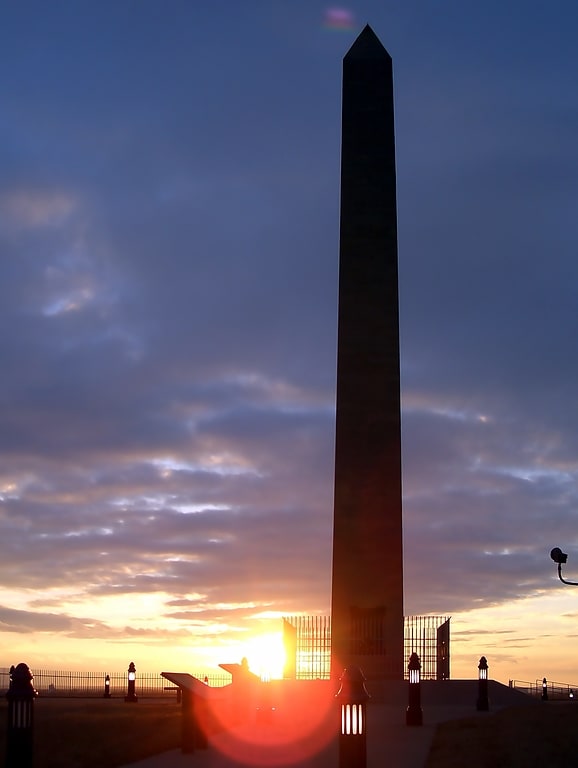
Monument in Sioux City, Iowa. The Sergeant Floyd Monument is a monument on the Missouri River at Floyd's Bluff in Sioux City, Iowa, USA. The monument honors Charles Floyd, a member of the Lewis and Clark Expedition, who died on the upstream voyage in 1804 and was buried here.
The monument is the first designated National Historic Landmark of the United States.[6]
Address: S. Lewis Blvd, Sioux City (Morningside)
Lewis & Clark Interpretive Center and Betty Strong Encounter Center
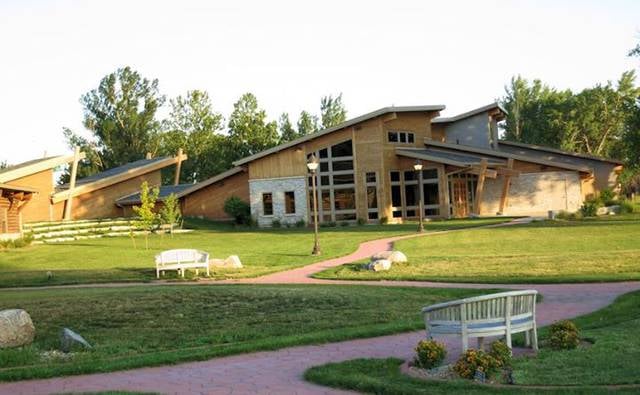
Museum, History museum
Address: 900 Larsen Park Rd, 51103-4916 Sioux City (West Side)
Siouxland Veterans Memorial Bridge

Through arch bridge in South Sioux City, Nebraska. The Siouxland Veterans Memorial Bridge is a through arch bridge which carries U.S. Route 77 across the Missouri River between Sioux City, Iowa, and South Sioux City, Nebraska.
The bridge replaced the Combination Bridge, so called because it carried both rail and highway traffic, built in 1896. The previous bridge was documented by the Historic American Engineering Record in 1980, prior to its replacement.
The current bridge was dedicated in July 1981, and the previous one was demolished. However, in May 1982 a 32-inch (810 mm) crack was discovered in the downstream tie girder. The bridge was hurriedly closed, and measures taken to ensure that it would not collapse into the river, affecting barge traffic. Initially, it was estimated that repairs would take six days; in fact, the bridge was completely closed for seven months, and did not fully re-open to traffic until May 1983.[7]
Address: US Highway 77, 68776 South Sioux City (West Side)
Holy Trinity Greek Orthodox Church
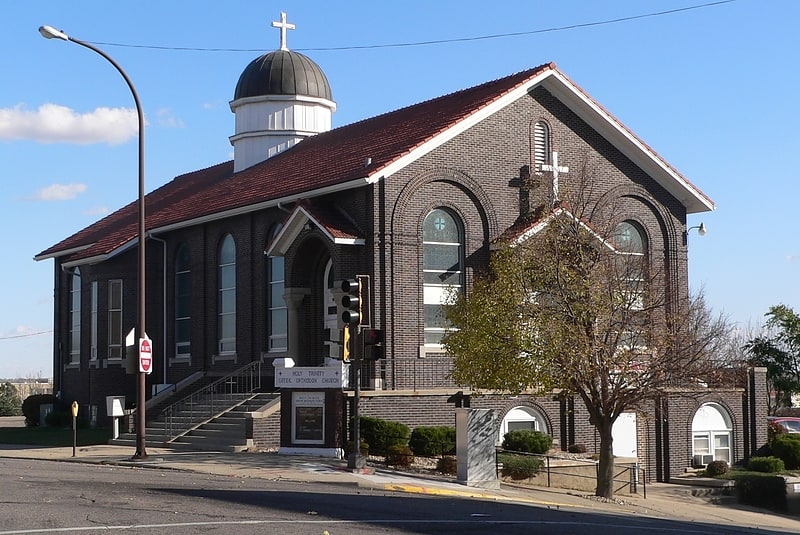
Church in Sioux City, Iowa. Holy Trinity Greek Orthodox Church is located in Sioux City, Iowa, United States. Designed by architect William L. Steele, the church building has been listed on the National Register of Historic Places since 1998.[8]
Address: 900 6th St, 51101-1818 Sioux City
Peirce Mansion
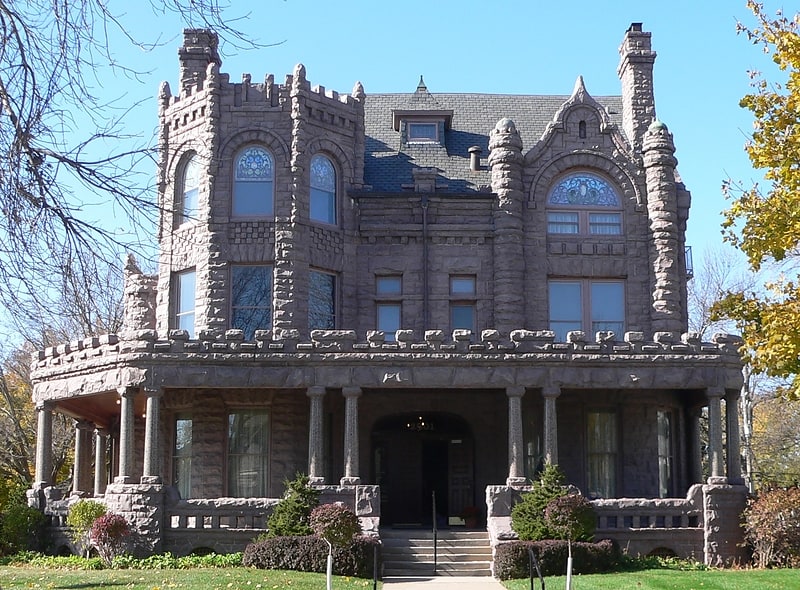
Mansion in Sioux City, Iowa. The Peirce Mansion is a 23-room mansion located in Sioux City, Iowa. From 1960 until 2011, the mansion was home to the Sioux City Public Museum with exhibits relating to the history of the region. It is still owned by the Sioux City Public Museum and has now been restored to a Victorian-era appearance. It is open to the public for quarterly open house events and is available for rental.
The mansion was listed on the National Register of Historic Places in 1978.[9]
Address: 2901 Jackson St, Sioux City (North Side)
Woodbury County Courthouse
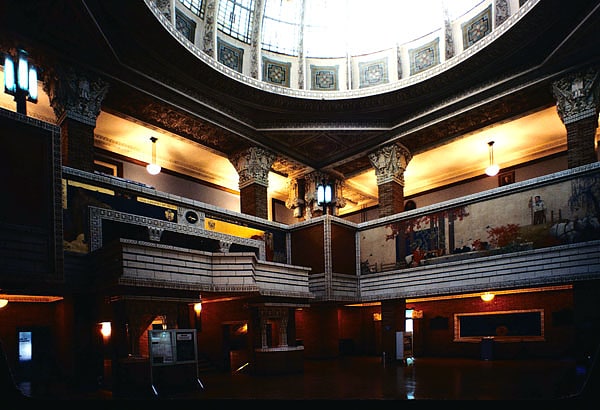
Building in Sioux City, Iowa. The Woodbury County Courthouse is located at 620 Douglas Street in Sioux City, the county seat of Woodbury County, Iowa, United States. It is regarded as "one of the finest Prairie School buildings in the United States" and has been declared a National Historic Landmark for its architecture. It is used for legal proceedings in the county.[10]
Address: 620 Douglas St, 51101-1247 Sioux City (North Side)
First Congregational Church

Congregational church in Sioux City, Iowa. The First Congregational Church, also known as Iglesia Pentecostes Evangelica Principe de Paz, is a house of worship located in Sioux City, Iowa, United States. An architectural rarity, it is one of a small group of churches in the Prairie School style of architecture. Designed primarily in the Prairie style with some eclectic touches by architect William L. Steele, its horizontal lines are emphasized by Roman brick and crisp rectilinear forms. Somewhat at variance are the distinctive dome and the prominent round heads on the windows.
Fresh from his triumph with the Woodbury County Courthouse in collaboration with George Grant Elmslie, and drawing on lessons learned during that collaboration, Steele built the church in 1916–1918. This church and the courthouse are the only two Prairie style buildings that are known to have a dome.
It was built for a Congregational church that had been established in Sioux City back in 1857, replacing a more traditional church that had burned down in 1916. In 1966, that congregation built a new structure on Hamilton Boulevard. First Congregational Church sold the building to Sioux City Baptist Church c. 1968. It was listed on the National Register of Historic Places in 1979 under that name. In 2009, Sioux City Baptist Church acquired a building on Viking Drive. Most recently, the building has become the Iglesia Evangelica Pentecostes Principe de Paz (Evangelical Pentecostal Church of the Prince of Peace), with services in Spanish aimed at the local Hispanic community.
Due to the need for extensive building restoration and maintenance, the structure has been named to endangered building lists by at least two historic preservation groups.[11]
Grandview Park Music Pavilion
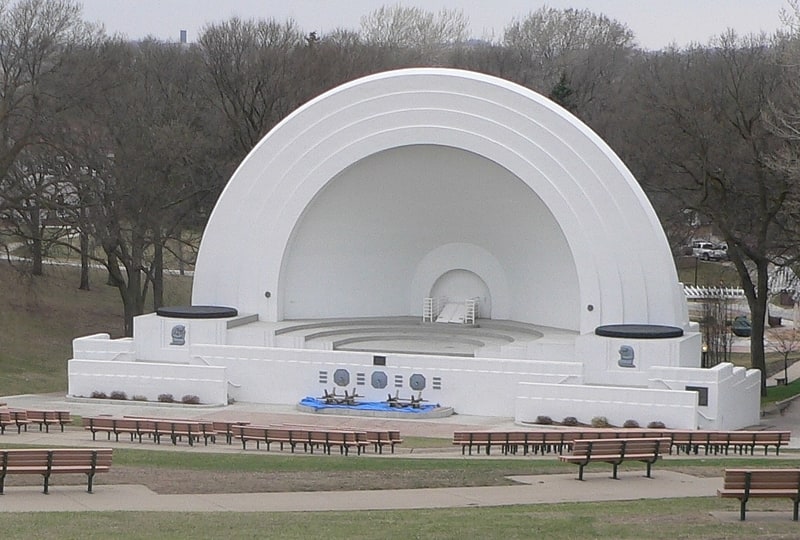
The Grandview Park Music Pavilion is a historic structure located in Sioux City, Iowa, United States. The Monahan Post Band raised money in 1930 to build a modest music shell in the park. Construction was already underway when the park's neighbors objected to the design. The project was put on hold as the band raised more money and sought a more suitable design. After President Franklin D. Roosevelt created the Civil Works Administration in 1933, the city applied to have the new music shell included in Sioux City's projects. Henry L. Kamphoefner, an unknown Sioux City architect at that time, drew up the plans for the structure. The sculptural plaques on the front of the pavilion were designed by Herschel Elarth. The CWA approved the project on February 26, 1934, as CWA Project Number 217. The construction project required 52 tons of reinforcing steel, 4,200 bags of Portland cement, and 300 bags of white cement, and it was completed on October 17, 1934. Seating was constructed for 5,000 in the natural amphitheater. The pavilion was built using $47,436 from Federal Relief funds and $3,800 in materials from the city. It was dedicated in the spring of 1935. The Monahan Post Band continued to play here until 1948, when they became the Sioux City Municipal Band. They continue the summer-time tradition. The music pavilion was listed on the National Register of Historic Places in 2011.[12]
Address: Grandview Blvd., 51104 Sioux City (North Side)
St. Boniface Catholic Church
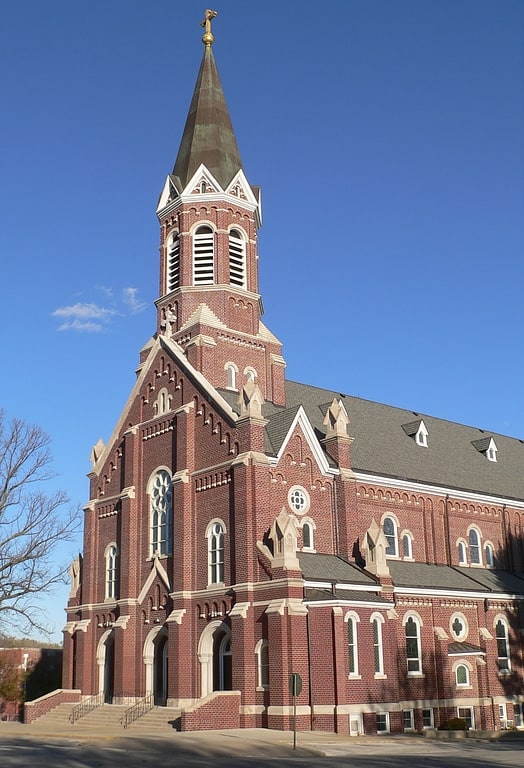
Building in Sioux City, Iowa. St. Boniface Catholic Church is a parish of the Diocese of Sioux City. The church is located in a residential area west of downtown Sioux City, Iowa, United States. The parish buildings form a nationally recognized historic district that was listed on the National Register of Historic Places in 1998 as St. Boniface Historic District. At the time of its nomination it contained three resources, all of them contributing buildings.[13]
Address: 703 W 5th St, 51103 Sioux City (West Side)
Augustana Lutheran Church
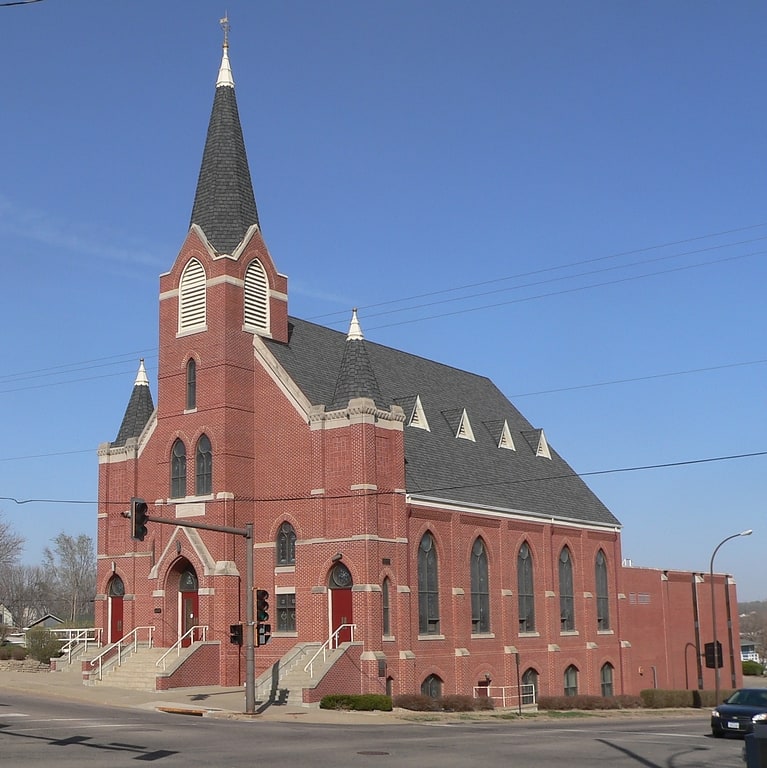
Lutheran church in Sioux City, Iowa. Augustana Lutheran Church is an Evangelical Lutheran Church in America congregation located in Sioux City, Iowa, United States. The church building was listed on the National Register of Historic Places in 2006 as Swedish Evangelical Lutheran Augustana Church.[14]
Address: 600 Court St, 51105 Sioux City
St. Thomas Episcopal Church
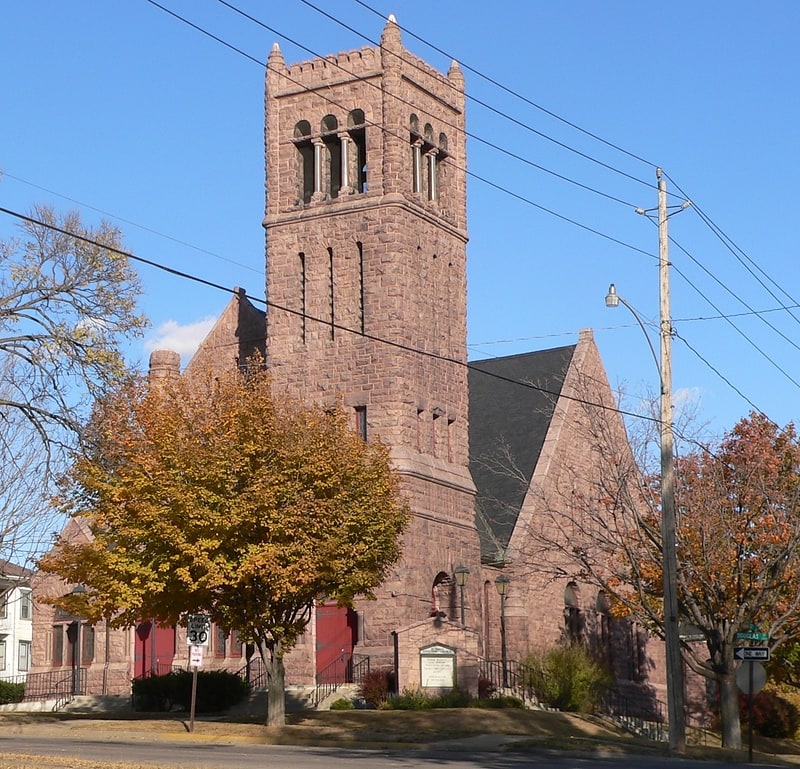
Parish church in Sioux City, Iowa. St. Thomas Episcopal Church is a parish church in the Episcopal Diocese of Iowa. The church is located in Sioux City, Iowa, United States. The church building was listed on the National Register of Historic Places in 1984.[15]
Address: 406 12th St, 51105-1305 Sioux City (North Side)
Simmons Hardware Company Warehouse
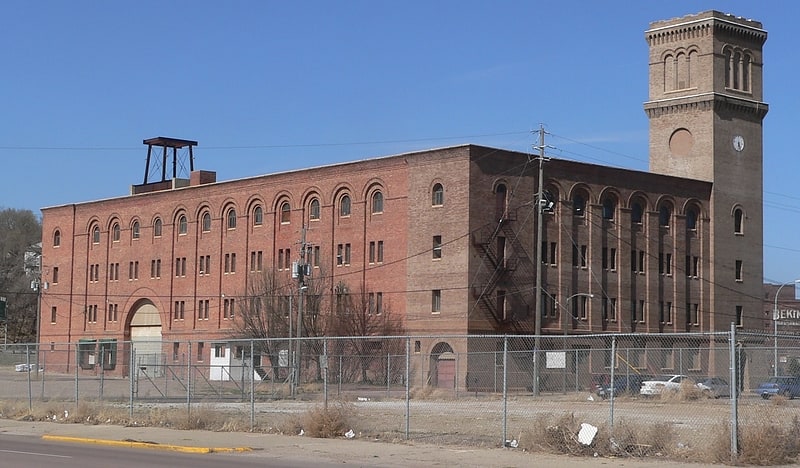
Warehouse in Sioux City. The Simmons Hardware Company Warehouse, also known as the Battery Building, is a historic warehouse located in Sioux City, Iowa that is on the National Register of Historic Places. The six storey building covered a whole block and its construction was supervised by Frank Bunker Gilbreth, Sr. the time and motion study pioneer.[16]
Boston Block
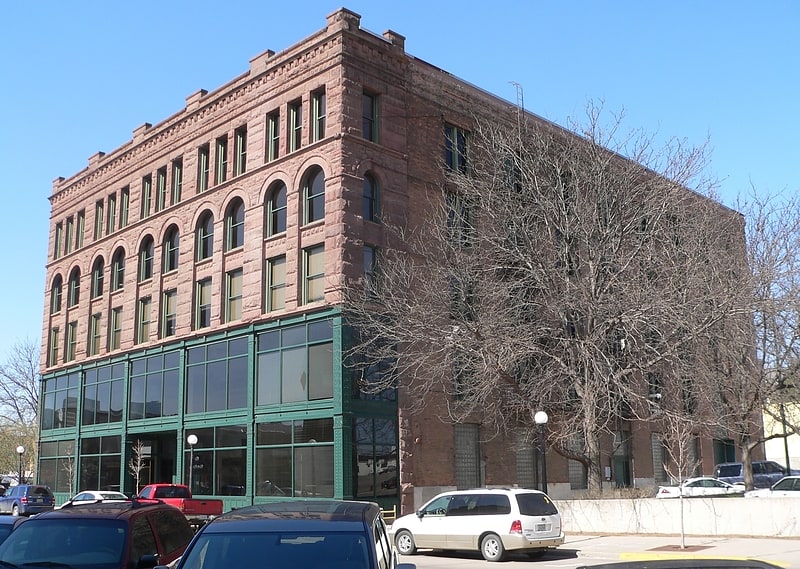
The Boston Block, also known as Aalfs Manufacturing Company, is a historic building located in Sioux City, Iowa, United States. The city experienced a building boom that began in the late 1880s and continued into the early 1890s. One of the major players in that building boom was the Boston Investment Company, a company on the East Coast who built four large commercial blocks in Sioux City simultaneously. Construction on the four buildings began in 1890 and they were completed the following year. In addition to the commercial blocks, they also built a steam heating plant that provided steam and light to three of the buildings as well as to neighboring buildings. The Massachusetts Block on the southwest corner of Fourth and Jackson was six stories tall and had a similar facade as the Boston Block, which is five stories tall on the northeast corner of Fourth and Virginia. The Plymouth Block on the southeast corner of Fourth and Locust was also five stories tall, and the Bay State Block on Fourth Street is the shortest at four stories. Among the building's tenants was the Aalfs Manufacturing Company, which used the building as its headquarters.
The architect of the four buildings is unknown, but John G. Mainland served as supervising architect. The Boston Block is a Richardsonian Romanesque structure that features rusticated stone veneer with a two-story iron and glass storefront. The original storefront was extensively altered in 1948, and it was altered again in 1984. The building was individually listed on the National Register of Historic Places in 1985, and as a contributing property in the Fourth Street Historic District in 1995.[17]
Evans Block

The Evans Block, also known as Northwestern National Bank Building, is a historic building located in Sioux City, Iowa, United States. The city experienced a building boom that began in the late 1880s and continued into the early 1890s. Fred T. Evans, an entrepreneur who had business interests in Iowa, Nebraska and South Dakota, had this building constructed to house Northwestern National Bank of which he was the president. The bank occupied the main level and other offices were housed on the upper floors. Local architect Charles Brown designed the four-story Romanesque Revival style building. The Black Hills sandstone for the public facades was from Evans' quarry. The Panic of 1893 brought Sioux City's building boom to an end, and the Evans block was sold in January 1895. Subsequently, the building has housed a hotel, a factory, a saloon, and a variety of stores. It was individually listed on the National Register of Historic Places in 1985, and as a contributing property in the Fourth Street Historic District in 1995.[18]
Federal Building and United States Courthouse

Building. The Federal Building and United States Courthouse is located in Sioux City, Iowa, United States. The present city hall in Sioux City was previously the post office, federal building and courthouse. This building replaced it. It was designed by the local architectural firm of Beuttler & Arnold with the Des Moines firm of Proudfoot, Rawson, Souers & Thomas providing input and oversight. Construction began in 1932 under the direction of the Acting Supervising Architect of the Treasury James A. Wetmore. The building was dedicated on December 29, 1933. The Federal Government had paid $270,000 for the property, and about $725,000 on construction. Architecturally, the three-story, stone structure is a combination of Stripped Classicism and Art Deco. The post office moved to a new facility in 1984, and additional office space and a new courtroom were created in the building. A further renovation was undertaken from 1999 to 2000 and a third courtroom a judge's chamber, jury deliberation room, library, and holding cell for defendants were added. The building was listed on the National Register of Historic Places in 2013.[19]